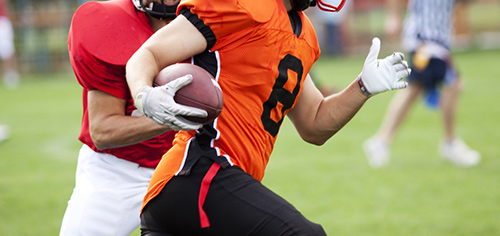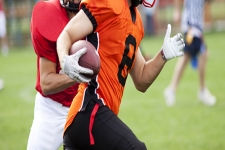
Summer is nearing the end, which means it’s time for school and fall sports to start up once again. Like every new season of sports, the fall brings an increased risk of injury when coming off of a break. According to Standard Children’s Health, about 30 million children and teens participate in some form of organized sports, and over 3.5 million injuries happen every year. This blog will discuss the most common injuries associated with fall sports and how to prevent injuries this season.
Fall Sports in Nebraska
In Nebraska, cross country, football, softball, girls golf, boys tennis, unified bowling, and volleyball are all fall sports. Many of these sports require strength and cardiovascular training to be able to safely compete. Participating in some type of pre-season training program can help improve skills, enhance overall fitness, and reduce the risk of injury.
Fall Sports Injuries
Here are a few sporting injuries that you’ll likely see this fall:
Concussions
Concussions can happen in any sport, but they most commonly occur in contact sports, like football. Any kind of hit to the head must be examined promptly to prevent a more serious head injury. Continuing to play with a head injury can lead to further and more serious damage. Here are the signs to look for in a concussion injury:
- Headache
- Nausea
- Dizziness
- Bothered by noise or light
- Blurry vision
- Confusion
- Fatigue
Fractures
Once again, fractures are most frequently seen in contact sports after impact. A fracture occurs when a bone is cracked or broken. It can happen to any bone in the body, but hands, wrists, collarbones, ankles, and feet all vulnerable areas. Stress fractures are also common in sports that require repetitive motions, like cross country running. Common symptoms of a fracture are:
- Swelling
- Redness
- Pain
- Limited movement
- May break the skin
Strains and Sprains
Other types of usual sporting injuries are strains and sprains. Strains and sprains happen when a tissue is stretched or torn. Strains involve muscles and tendons; whereas, sprains involve ligaments. These types of injuries are often caused by minor trauma, such as twisting a joint, overuse, or force. It’s important to take a time out when dealing with a strain or sprain as exertion can make it worse. Signs of a strain and sprain are:
Strain
- Pain or tenderness
- Redness or bruising
- Limited movement
- Muscle spasms
- Swelling
- Weakness
Sprain
- Pain
- Swelling
- Bruising
- Restricted movement
- Popping
Shin Splints
There are many causes of shin splints, but the most popular are stress fractures and overexertion. Shin splints are caused by overuse of the muscles attached to the bone, which then causes inflammation. It typically flares up when partaking in a recently intensified running or exercising routine. The most common symptoms of shin splints are:
- Tenderness
- Soreness
- Pain
Preventing Injuries
The first step in preventing an injury is simply being aware that an injury can happen. This makes prevention easier when you know the risk involved. Here are a few things to do to help prevent a sporting injury:
- Get a physical before the season starts
- Stretch, warm-up, and cool-down
- Participate in strength training
- Wear the proper uniform and equipment
- Eat a well-balanced diet and drink plenty of water
- Take breaks
- Rest after an injury
Visit Prairie Ortho
No one wants to sit on the sidelines because of an injury, but if it happens, come visit us a Prairie Orthopaedic & Plastic Surgery in Lincoln, NE. Our medical providers are equipped to restore function and get our injured patients back on the field and to their sport once again. We wish all of our fall athletes a safe, healthy, and victorious season!
To schedule an appointment at Prairie Ortho, please call 402-489-4700.

